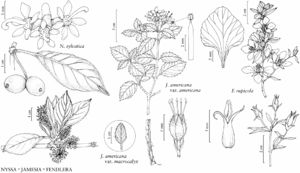Fendlera
Smithsonian Contr. Knowl. 3(5): 77, plate 5. 1852.
| Taxon | Illustrator ⠉ | |
|---|---|---|
 | Nyssa sylvatica Fendlera rupicola Jamesia americana var. macrocalyx Jamesia americana var. americana | Yevonn Wilson-Ramsey Yevonn Wilson-Ramsey Yevonn Wilson-Ramsey Yevonn Wilson-Ramsey |
Shrubs. Stems ascending or spreading. Bark exfoliating in grayish or reddish strings or strips, or sometimes not exfoliating. Branches erect or arching; twigs with simple and minutely branched trichomes. Leaves deciduous, opposite, sometimes clustered on short-shoots; petiole present, relatively short; blade linear, elliptic, lanceolate, oblong, ovate, or falcate, herbaceous or coriaceous, margins entire, plane or strongly revolute; venation acrodromous, lateral-veins sometimes obscure. Inflorescences terminal, flowers solitary; peduncle absent. Pedicels present. Flowers bisexual; perianth and androecium nearly hypogynous; hypanthium completely adnate to ovary, turbinate, broadly campanulate, or hemispheric, weakly or strongly 4-ribbed or 8-ribbed in fruit; sepals persistent, 4, eventually erect or strongly recurved, usually triangular, sometimes ovate, glabrous or hairy; petals 4, imbricate, spreading, white, sometimes tinged pink or red, broadly spatulate, base clawed, surfaces finely pubescent; stamens 8; filaments distinct, dorsiventrally flattened, gradually tapered toward apex, apex 2-lobed, lobes prolonged beyond anthers; anthers oblong; pistil 4 (–5) -carpellate, ovary to 1/2 inferior, 4 (–5) -locular; placentation axile; styles persistent, 4 (–5), distinct. Capsules ovoid-ellipsoid, ± cartilaginous, dehiscence basipetally septicidal to middle of fruit. Seeds (1–) 2–4 (–6) per locule, reddish-brown, ellipsoid. x = 11.
Distribution
sw United States, n Mexico
Discussion
Species 2 (2 in the flora).
A. J. Rehder (1920) found that the species of Fendlera show great uniformity in floral characters and may be distinguished easily by their leaves. N. H. Holmgren and P. K. Holmgren (1997) also reported that floral characters are remarkably uniform.
B. L. Turner (2001) recognized five species of Fendlera, including four in the flora. In addition to the species recognized here, B. L. Turner also recognized F. falcata and F. wrightii in our area; as noted later, these are best included within F. rupicola. The fifth species of Turner is F. tamaulipana, a taxon from Tamaulipas, Mexico; this species is here included in F. linearis.
Inflorescences of Fendlera have been described as solitary flowers or as clusters of two, three, or five flowers, racemes, or dichasial cymes. The inflorescence consists of a single flower terminating a leafy branch; these flower-bearing branches are sometimes aggregated. Frequently, the lateral branches are much-reduced and consist of a relatively short axis bearing two relatively small leaves and terminated by a flower. More rarely, the flowers appear nearly sessile in leaf axils, subtended by scales; this phenomenon is most frequent in F. linearis.
As in some species of Philadelphus, the buds on the long shoots of Fendlera are hidden in pouches of tissue at the bases of the petioles.
Selected References
Lower Taxa
Key
| 1 | Leaf blades coriaceous, linear, 1.3–2 mm wide, margins strongly revolute, touching midvein, abaxial surface hidden, adaxial surface with scattered, appressed trichomes; midvein 0.5–1 mm wide, flat. | Fendlera linearis |
| 1 | Leaf blades herbaceous to coriaceous, usually elliptic, lanceolate, oblong, ovate, or falcate, rarely linear, 2–10 mm wide, margins plane to revolute, not touching midvein, abaxial surface visible, strigose, sometimes with understory of minute, finely branched trichomes, adaxial surface with appressed trichomes and/or short, erect trichomes; midvein 0.2–0.3 mm wide, raised. | Fendlera rupicola |
"connate" is not a number. "distinct" is not a number.